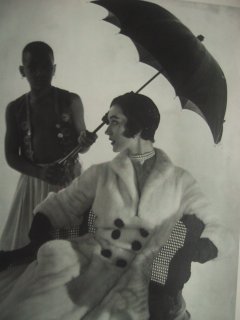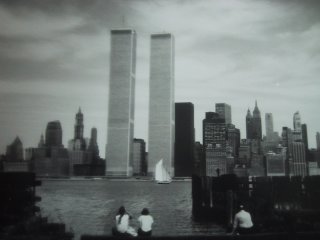Edgar de Evia was born in Merida where his great grandfather had been a governor or the Yucatan when it was separate from Mexico. He moved with his parents to New York City ca. 1915 and was graduated from the Dalton School.
After a brief period with AP he took the position of research assistant to the Doctor Guy Beckley Stearns where he worked with the Boyd Emmanometer developed by Doctor William E Boyd in Glasgow, Scotland. The doctor gave the young de Evia a RolleiFlex and would take him on walks though the park at lunchtime. Coaching him he would explain how the camera could not think and that he must learn to see what the lens saw to interpret for the camera.
Living in the same building where the doctor's laboratory was housed was the grandmother of Robert Denning 1927-2005, who just died on 26 August 2005 and would go on to become the celebrity decorator. His New York Times obituary by Mitchell Owens appeared in Paris and from coast to coast in this country. One newspaper ran this under the headline HE FEATHERED THE NESTS OF THE RICH AND FAMOUS.
I was fortunate to know Edgar for forty years and in the last years of his life Bod, Edgar and I spent many evenings together over dinner. As I sort and organize the huge collection of photographs, negatives and transparencies I will try to scan the better ones and post them to this thread for comment. There are photographs of many of the famous models from Lisa Fonssagrives and Dovima to Wilhelmina.
His photographs appeared in both editorial assignments as well as many commercial accounts. He never lost his love of photography and well into his eighties he would mount his bicycle with a backpack carrying his latest camera to take off on an experimental photoshoot be it in lower Manhattan or to take the train to Connecticut or upstate New York where he would get off and unfold his bicycle and ride to a point of interest. I've found over forty unique photographs of lower Manhattan which include the World Trade buildings, so far. One of his first photographs of the twin towers was of me when the first tower was under construction in 1969.
Any posts of other photographs by Edgar de Evia and comments on his work and life would be welcomed.
After a brief period with AP he took the position of research assistant to the Doctor Guy Beckley Stearns where he worked with the Boyd Emmanometer developed by Doctor William E Boyd in Glasgow, Scotland. The doctor gave the young de Evia a RolleiFlex and would take him on walks though the park at lunchtime. Coaching him he would explain how the camera could not think and that he must learn to see what the lens saw to interpret for the camera.
Living in the same building where the doctor's laboratory was housed was the grandmother of Robert Denning 1927-2005, who just died on 26 August 2005 and would go on to become the celebrity decorator. His New York Times obituary by Mitchell Owens appeared in Paris and from coast to coast in this country. One newspaper ran this under the headline HE FEATHERED THE NESTS OF THE RICH AND FAMOUS.
I was fortunate to know Edgar for forty years and in the last years of his life Bod, Edgar and I spent many evenings together over dinner. As I sort and organize the huge collection of photographs, negatives and transparencies I will try to scan the better ones and post them to this thread for comment. There are photographs of many of the famous models from Lisa Fonssagrives and Dovima to Wilhelmina.
His photographs appeared in both editorial assignments as well as many commercial accounts. He never lost his love of photography and well into his eighties he would mount his bicycle with a backpack carrying his latest camera to take off on an experimental photoshoot be it in lower Manhattan or to take the train to Connecticut or upstate New York where he would get off and unfold his bicycle and ride to a point of interest. I've found over forty unique photographs of lower Manhattan which include the World Trade buildings, so far. One of his first photographs of the twin towers was of me when the first tower was under construction in 1969.
Any posts of other photographs by Edgar de Evia and comments on his work and life would be welcomed.






 Lisa Fonssagrives was one of the top sophisticated models of her time. She was married to two photographers, first to Fernand Fonssagrives, who also died in 2003 although they had been divorced and both remarried, and she was then married to Irving Penn.
Lisa Fonssagrives was one of the top sophisticated models of her time. She was married to two photographers, first to Fernand Fonssagrives, who also died in 2003 although they had been divorced and both remarried, and she was then married to Irving Penn.

